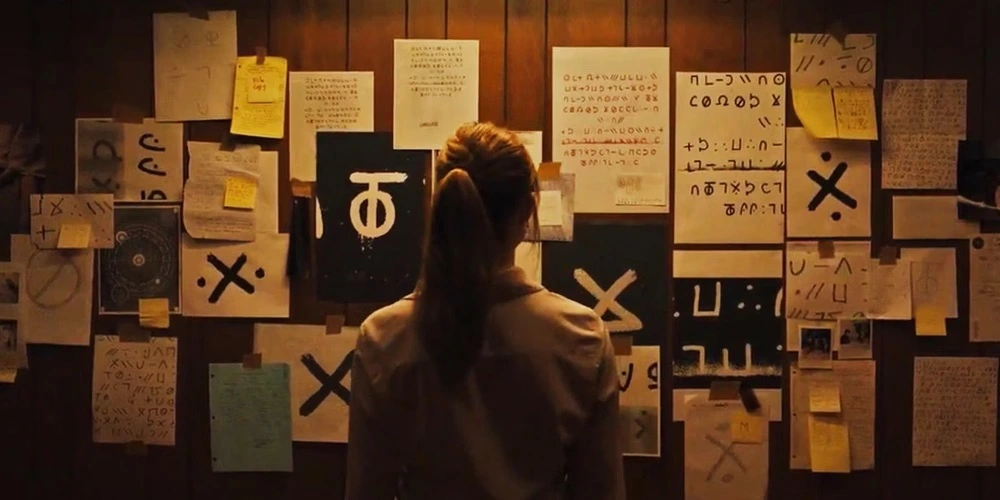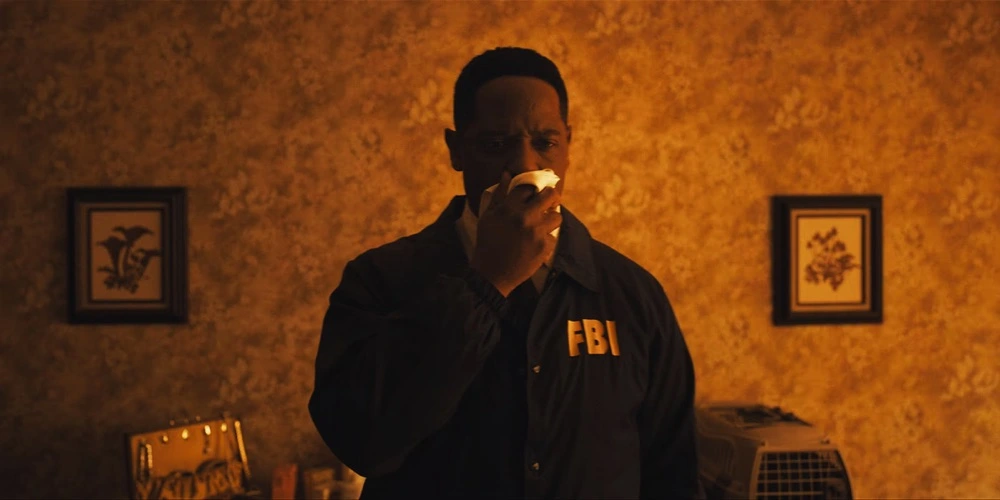Cast: Maika Monroe, Nicolas Cage, Blair Underwood, Alicia Witt
Genre: Psychological Horror, Serial Killer, Crime, Horror, Thriller
Director: Osgood Perkins
In Irish Cinemas: 12th July 2024
Much like the unsettling phenomenon of liminal spaces in the online world, “cursed images” transform the ordinary into the eerie by casting a spotlight on the shadowy voids at the periphery of our perception. Osgood Perkins, known for his work on The Blackcoat’s Daughter, employs a similar technique in his latest film, Longlegs. Here, he meticulously reconfigures familiar horror tropes to imbue them with an aura of otherworldly menace. Perkins’ take on the serial killer thriller merges the gritty authenticity of a crime-scene photograph with the jarring surrealism of a nightmare. The result is profoundly disconcerting, evoking a sense of taboo—as though we are witnessing something forbidden, with an implicit warning that such knowledge comes at a brutal cost.
The film immediately sets a sinister tone, leaving a lasting impression from the beginning. The opening sequence unfolds like a nostalgic home movie, lulling viewers into a false sense of security before abruptly shattering that comfort with a chilling twist. Osgood Perkins deftly bridges the gap between true-crime aesthetics and eerie supernatural elements through the character of rookie FBI agent Lee Harker, portrayed by Maika Monroe. While combing through a nondescript suburban neighbourhood with her partner, Agent Harker experiences an intense intuition, pinpointing a seemingly random house as the suspect’s hideout. To the astonishment of her colleagues—but not the audience—her intuition proves eerily accurate, setting the stage for the film’s unnerving exploration of the unknown.
Thus, her superior, Agent Carter (Blair Underwood), assigns Lee to a perplexing and disturbing case. Several seemingly idyllic suburban families have been brutally eradicated in what initially appears to be classic “family annihilator” scenarios—a grim subject even within the realm of murder mysteries. The crimes seem like straightforward murder-suicides, except for one inexplicable detail: despite the absence of any signs of forced entry or external tampering, coded letters signed “Longlegs” were discovered at each crime scene. The confounding question arises: if no intruder accessed the houses before, during, or after the murders, how did these cryptic messages find their way inside? This anomaly adds a sinister mystery to the investigation, suggesting a chilling and unseen presence.

Agent Carter suspects that “Longlegs” is manipulating the killers from a distance, prompting him to enlist Harker and her newly discovered intuitive abilities for the case. “He instructs them on what to do to themselves and each other, and they comply,” Carter explains. The coded messages left by Longlegs bear a striking resemblance to those of the infamous Zodiac Killer, and during their discussions, the agents frequently reference Charles Manson’s manipulative tactics. By intertwining these historical crimes with elements of occult fiction, the film blurs the boundaries between reality and the supernatural. This melding of fact and fiction is central to the film’s eerie and unsettling impact, amplifying its uncanny power and leaving audiences questioning the nature of the horrors they witness.
Perkins adds another layer of destabilisation by subjecting Lee—and, by extension, the audience—to a slideshow of (staged) autopsy photos paired with recordings of (staged) 911 calls. As Carter details the implications of these gruesome crimes to his psychic protégé, these jarring visuals and sounds create a deeply unsettling atmosphere. A recurring blood-splatter motif and subliminal flashes of demonic imagery in red and black hues intensify the fleeting glimpses of gore and mutilation. Perkins’ screenplay also employs a hypnotic repetition of eerily childlike phrases—such as “big bad wolf” and “nasty stuff”—further enhancing the film’s haunting and disorienting effect.

Lee plunges headfirst into the grisly mystery, and the tension escalates as she discovers that Longlegs not only knows her name and where she lives, but they had also crossed paths once, long ago. This revelation marks a turning point in the film, drawing parallels to The Silence of the Lambs, with Maika Monroe assuming the role of a modern Clarice Starling. When Longlegs, played by Nicolas Cage, finally appears on screen, he emerges as a Satanic counterpart to Buffalo Bill. Adorned in makeup and glam rock attire, he exudes a disturbing presence but without the problematic trans storyline. Instead, Cage channels a warbly-voiced eccentric reminiscent of Tiny Tim—a performance that would seem outrageous to anyone else but feels perfectly natural for Cage, adding a unique and unsettling dimension to the character.
There’s no mistaking that Longlegs is unmistakably the work of Osgood Perkins, even when it echoes the style of others. Maika Monroe shines as the capable and courageous Agent Lee Harker, particularly in her scenes with Alicia Witt, who plays Lee’s fragile mother, Ruth. While Monroe struggles to maintain the central focus as the conspiracy deepens and the murder methods grow increasingly bizarre, she brings a lean athleticism to the role. This physicality convinces audiences that she has the resilience to survive until the end—a trait that has earned her the “final girl” label in films like It Follows, The Guest, and Watcher. Though the term “final girl” doesn’t quite fit here, as Longlegs is more of a procedural than a slasher, the underlying spirit of tenacity and survival remains the same.

Perkins has a distinct directorial identity, characterised by his overcast colour palette and an American Gothic farmhouse aesthetic. This is evident in The Blackcoat’s Daughter, and I Am the Pretty Thing That Lives in the House. This unmistakable style is also present in Longlegs, even when it bears similarities to the works of other filmmakers. There are moments when Longlegs feels like a movie you’ve seen before, but with an evil twist: This duality is both a weakness and a strength. Perkins’ brand of horror surrealism makes the familiar seem strange, and the strange seem familiar, putting viewers in a state of vulnerability—creating the perfect opening for something truly unholy to slip in.
Director Osgood Perkins infuses his distinctive style into this serial-killer procedural, blending gritty true-crime elements with eerie Satanic horror. Maika Monroe, known for her role in It Follows, stars as a fearless FBI agent reminiscent of Clarice Starling. At the same time, Nicolas Cage takes on the role of her adversary in a uniquely Cage fashion, channelling a Buffalo Bill-like menace. Supernatural elements permeate the narrative, distorting our perception of reality and giving the unsettling impression that evil forces emanate directly from the film.
Overall: 7/10


















